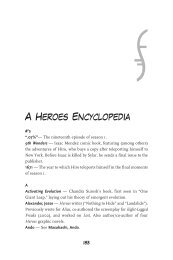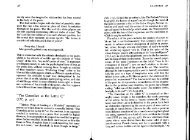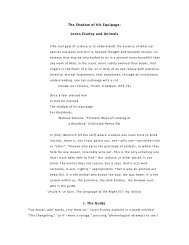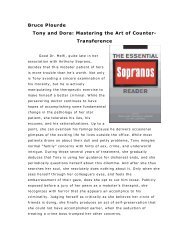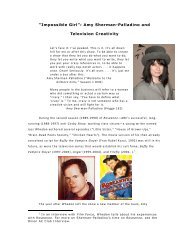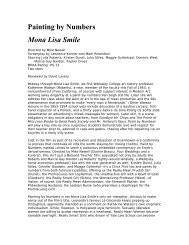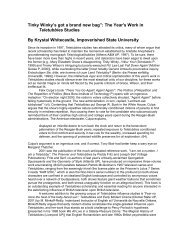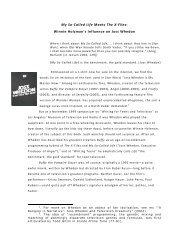Sopranos - David Lavery
Sopranos - David Lavery
Sopranos - David Lavery
Create successful ePaper yourself
Turn your PDF publications into a flip-book with our unique Google optimized e-Paper software.
William C. Siska<br />
“If all this is for nothing”:<br />
The <strong>Sopranos</strong> as Art Cinema<br />
For my money, the greatest praise<br />
The <strong>Sopranos</strong> received came from Norman<br />
Mailer, who said in so many words that<br />
The <strong>Sopranos</strong> had fulfilled the dream of<br />
the Great American Novel more than any<br />
other contemporary literary work. 1 Mailer<br />
cited the depth of characterization and<br />
the broad social scope of the narrative,<br />
and could have added the American<br />
themes of lust, greed, and the<br />
inevitability of betrayal as bases in<br />
support of his judgment.<br />
But to rise to the level of literature,<br />
a television series or movie must additionally possess a dimension of<br />
introspection that is foreign to a medium that favors action, simplicity,<br />
and transparency in characters that nearly always turn out to be what<br />
they seem at first sight. Unlike American television, where the<br />
protagonist is a figure of good – on the side of law and good manners -<br />
doing battle with evil and error, literature admits to its pantheon<br />
contradictory figures wherein evil and good abide simultaneously and<br />
resolutions can be ambiguous or downbeat. Finally, when we consider<br />
literature, whether Huckleberry Finn or The Great Gatsby, War and<br />
Peace or Crime and Punishment, we value it not solely for its<br />
representation of the world, but for its contemplation about what that<br />
world means. The great director Jean Renoir achieved this in cinema<br />
twice, in The Grand Illusion and The Rules of the Game, films whose<br />
philosophical dimensions illustrate his seminal quote, “A man is not<br />
only what happens to him, but what happens to him and what he thinks<br />
about it.” 2
Woody Allen, writing about Ingmar Bergman in The New York<br />
Times on the occasion of the publication of Bergman’s autobiography,<br />
argued that while the cinema normally confines itself to external<br />
action, Bergman found a cinematic style to reveal a character’s inner<br />
states and focus on a battlefield of the soul 3 . Michelangelo Antonioni,<br />
Federico Fellini, and <strong>David</strong> Chase, in The <strong>Sopranos</strong>, have also found<br />
ways to dramatize internal conflicts.<br />
The most obvious method for introspection in The <strong>Sopranos</strong> is<br />
the device of the therapist, where precisely what is paid for is a tour<br />
of one’s own head. The preponderance of dreams in The <strong>Sopranos</strong><br />
offers another inroad to the mind. These are but two of the ways The<br />
<strong>Sopranos</strong> rejects television’s standard operating practice, and locates<br />
itself in the orbit of the European art cinema, where interior<br />
consciousness tied to contemplation of abstract issues finds its way<br />
onto the screen.<br />
The genesis of this essay comes from a conversation I had with<br />
<strong>David</strong> Chase in 1970, when we were film students together, and he<br />
quipped, “Why should I go to a Bergman movie. If I want to get<br />
depressed I fight with my wife.” 4 Imagine my surprise, then, when in<br />
the third episode of The <strong>Sopranos</strong>, the key question raised by Ingmar<br />
Bergman in The Seventh Seal is echoed by Tony Soprano in a session<br />
with Dr. Melfi, a question which will recur throughout the six seasons<br />
of the series.<br />
“What if all this [i.e., our earthly life] is for nothing? And if it’s<br />
for nothing, why do I got to think about it?” Tony remonstrates to<br />
Melfi, in a dialogue that could be inserted into the confessional scene<br />
in The Seventh Seal. “That’s the question, isn’t it, the question of God<br />
or whatever you want to call it,” Melfi says, “and why we’re given the<br />
questionable gift of knowing we’re going to die.” Without proof of<br />
God’s existence, the Knight says, the fact of death is too heavy a<br />
burden to bear, and “Life is a senseless horror.” Tony, like Bergman’s<br />
Knight, is facing the unbearable.
“If all this is for nothing…” (Season One, Episode 3)<br />
The Seventh Seal (1957)
In the seventh episode of part two of the sixth season of The<br />
<strong>Sopranos</strong>, A.J. complains to Meadow, “Don’t you think this is all<br />
meaningless?” While Tony’s peering into the void is treated with<br />
seriousness, A.J. is the callow questioner and his despair is treated<br />
with mordant humor. “Maybe you should try setting some goals for<br />
yourself,” Meadow advises him.<br />
In The Seventh Seal, Bergman proposes that a community of<br />
sharing is the best life has to offer. Sharing a meal with the family of<br />
itinerant actors who have welcomed him to their midst, the Knight<br />
holds a bowl of milk in his hands like the chalice of the mass, and<br />
savors his appreciation of the moment. “This will be a sign, and a<br />
great content,” he tells his companions. “Remember the good times,”<br />
Tony tells his assembled family in the finale of Season One, hoisting<br />
another chalice, a glass of wine, “Times like these.” Several seasons of<br />
The <strong>Sopranos</strong> end with a gathering around a meal, though the meal as<br />
an attempt to affirm the positive in a negative world becomes<br />
increasingly ineffectual as the series progresses. And, of course, the<br />
series ends with a permanently suspended meal.
“Remember the good times. Times like these.” (Season One, Episode<br />
13)<br />
The Seventh Seal (1957)<br />
The <strong>Sopranos</strong> limns even more of Bergman than the introspection<br />
of the confessional and its correlative, the confessional of the<br />
therapist’s office. In The Passion of Anna, the Bergman film that<br />
occasioned Chase’s tart observation on art films and depression, the<br />
potential for violence simmering beneath the surface of close<br />
relationships and disturbing offenses against nature find their<br />
expression.<br />
Anna Fromm, played by Liv Ullmann, affirms in conversation the<br />
success of her marriage and the happy memories it has given her in a<br />
less satisfactory present. But, in fact, her marriage was a disaster, and<br />
she has gained her limp by crashing a car with her husband in it,
leading to his demise. Gradually her relationship with Andreas (Max<br />
von Sydow) falls prey to the same discontents that led to the<br />
destruction of her first union. Bergman masterfully traces the growth<br />
of this emotional disease beneath the rituals of their lives together,<br />
until it bursts through in shocking, almost B-movie violence, with<br />
Andreas burying an ax into the wall of his barn and flailing wildly at<br />
the outraged, cowering Anna.<br />
In the finale of Season Four of The <strong>Sopranos</strong>, which concludes<br />
with Carmela leaving Tony, the prelude to her flight is a vicious verbal<br />
altercation and the threat of physical violence. (A domestic quarrel<br />
later in the series does involve Tony beating Carmela.) But through the<br />
fifty-one episodes that preceded this one, the slow burn brought on by<br />
repeated lies and betrayals erupts into an emotional conflagration. In<br />
both dramas, psychic violence produces a chasm that pushes intimates<br />
apart.<br />
A key motif of the art cinema, one that <strong>David</strong> Chase says is also<br />
central to understanding The <strong>Sopranos</strong>, is the presentation of<br />
characters who lie to themselves. 5 The theme of lying to oneself and<br />
its effect on relationships factors in almost all of Eric Rohmer’s films,<br />
and Bergman is also obsessed with the idea of self-delusion and the<br />
devastating consequences once the façade constructed by lies is<br />
removed. Borg, the honored physician in Wild Strawberries, thinks of<br />
himself as a wise and self-composed success. During a journey with his<br />
angelic daughter-in-law, his mask of contented pride falls away, and<br />
he must face the truth that his life has been empty labor, and, at his<br />
advanced age, it’s too late for him to reverse it. This sense of loss with<br />
the passage of time, that his days have been filled with false pursuits<br />
that add up to nothing, also suffuses Tony Soprano’s experience of life.<br />
Alma, the shallow nurse who waits on her mute but<br />
psychologically powerful patient in Persona, thinks of her life as<br />
settled, and, when she admits that she has lied herself into a spurious<br />
contentment, she is left facing a void. The last word she speaks in the<br />
movie is “nothing.”
Similarly, Carmela Soprano, who some critics saw in the early<br />
seasons of the series as the moral center of the show, and whom they<br />
applauded in the fourth season for leaving Tony because of his<br />
unchecked corruption, is, like Bergman’s Anna, someone who lies to<br />
herself, about her ethical standards, the morality of her lifestyle, and<br />
where the money comes from. The result, Bergman says, and <strong>David</strong><br />
Chase seconds, is an inevitable descent into “psychological and<br />
physical violence.”<br />
The Passion of Anna (1969)
“Psychological and physical violence” (Season Four, Episode 13)
The Passion of Anna (1969)<br />
Violence towards animals represents a blight in the world larger<br />
than that contained in single characters like Anna Fromm or Tony<br />
Soprano. In The Passion of Anna, mindless cruelty to animals is an<br />
affront to nature. The burning of horses, which occurs after the<br />
suspect in earlier incidents of violence to animals has committed<br />
suicide, proves that evil haunts the landscape, and turns the act into a<br />
metaphor for a universal corrosion in existence itself.<br />
In The <strong>Sopranos</strong>, metaphorical incidents are forced by television<br />
practice to carry out a plot function, and the audience knows that the<br />
killing of Pie-O-My in episode 9 of Season Four has been arranged by<br />
Ralph Cifaretto as an act of revenge against Tony. Yet the<br />
metaphorical dimension in this act of killing is finally more powerful<br />
than the sadism of Ralphie’s vengeance. The horse represents the<br />
natural life to which Tony is drawn in the opening of the series when<br />
he warms to the migrating ducks in his swimming pool. His affection<br />
for the ducks and for Pie-O-My as his only attachments grow from pure<br />
feeling, relationships with neither demands nor expectations, free of<br />
the contractual give and take that rules his relations with people in<br />
both his family and his business.<br />
After the conflagration (Season Four, Episode 9)
Pie-O-My (Season Four, Episode 9)<br />
The Passion of Anna (1969)
Violence towards animals The Passion of Anna (1969)<br />
The defining characteristics of the European art cinema are the<br />
overt address of abstract issues – raised problems, like “the meaning<br />
of life” - in dialogue and by direction of the viewer to symbolic and<br />
metaphorical images 6 . American television and movies typically avoid<br />
the abstract to focus on lived problems: how to get across the street<br />
but not what it means “to cross.” American moviemaking, for all its<br />
pictorial virtuosity, tends to avoid visual symbolism, seemingly<br />
determined to prove Andre Bazin’s contention that the cinema, with its<br />
roots in photography, was destined to a kind of “vulgar realism,”<br />
where the camera records and presents literally only what it sees. This<br />
“vulgar realism” combined with the tyranny of plot practiced by<br />
Hollywood presents a problem for Chase in fulfilling the visual aspect<br />
of art cinema’s definition.<br />
The solution, for Chase, is to slip in metaphorical images within the<br />
guise of plot. Chase lamented that the dream sequences in The<br />
<strong>Sopranos</strong> could not be done like Fellini’s, freestanding juxtapositions of<br />
images revealing the character’s inner being without regard to plot,<br />
but had to move the story forward. 7 Metaphor, though, lies latent in
The <strong>Sopranos</strong>’ visual motifs: the repeated scenes in hospital rooms,<br />
the many automobile accidents and gunshot killings provide potent<br />
arguments for the harm resulting from relentless pursuit of the dollar,<br />
and create a milieu in which uncontrolled change and loss lie in wait<br />
for the characters.<br />
The influence of the art cinema on The <strong>Sopranos</strong> goes well<br />
beyond Bergman to embrace the themes of many other prominent<br />
directors of the genre. One may be tempted to greet with skepticism<br />
the notion that a creator of popular American television would be<br />
strongly shaped by a kind of movie as esoteric, intellectual, and<br />
decidedly, over the life-cycle of The <strong>Sopranos</strong>, as unpopular as art<br />
films. But this should come as no surprise, because in the late 1960s<br />
when <strong>David</strong> Chase was forming his ideas about how to make movies<br />
and what they should say, European art films were far more central to<br />
the audience passionate about movies as an art than anything coming<br />
out of Hollywood. Academy Award Best Picture winners from 1965 to<br />
1968, The Sound of Music, A Man for All Seasons, In The Heat of the<br />
Night, and Oliver were not nearly as compelling to people learning<br />
filmmaking as movies filtering in from across the sea, Juliet of the<br />
Spirits, The Red Desert, Persona, Weekend, and others. These were the<br />
titles film students went out of their way to see, because that’s what<br />
people were talking about, whether or not they would prove to be the<br />
future of cinema.<br />
When <strong>David</strong> Chase got to Hollywood, he found he had to learn<br />
storytelling from a perspective different than that of Fellini and Jean-<br />
Luc Godard. “I really didn’t know about story,” Chase said recently. “I<br />
thought 8 1/2 was a great story.” 8 But Chase ingested the seriousness<br />
of purpose, and the high artistic aspirations of the European art<br />
cinema, in many ways, are manifest in The <strong>Sopranos</strong>.<br />
The <strong>Sopranos</strong> is first and foremost a gangster saga, but, like the<br />
best films of Francis Ford Coppola and Martin Scorsese, it draws on the<br />
art cinema of Bergman, Fellini, and Godard. A significant part of the<br />
pleasure that we take in The <strong>Sopranos</strong> and the meanings we assign to<br />
it as an important achievement of American art, derive not only from
its effective reworking of gangster drama and family comedy, but also<br />
from an engagement with the intellectual questing and cinematic style<br />
of the European art cinema.
1 “Norman Mailer on the Medium and the Message.” www.Poynter.com. The<br />
Poynter Institute. 2004. February 6, 2004.<br />
2 Joseph McBride, “Interview with Jean Renoir,” Sight and Sound V. 24.4<br />
(London: BFI Publishing, 1971).<br />
3 Woody Allen, “Through a Life Darkly,” New York Times Book Review 12<br />
November 1988: 14.<br />
4 <strong>David</strong> Chase, in conversation, Palo Alto, California, February 1970.<br />
5 Fresh Air, National Public Radio, March 2, 2004.<br />
6 See William Siska, “Metacinema: A Modern Necessity,” Literature/Film<br />
Quarterly 7.1 (1979): 285-289, and Siska, Modernism in the Narrative Cinema: The<br />
Art Film as a Genre (NY: Arno Press, 1980).<br />
7 Martha Nochimson, Dying to Belong: Gangster Movies in Hollywood and<br />
Hong Kong (Malden, MA: Blackwell, 2007), 241 – 242.<br />
8 Peter Biskind, “An American Family,” Vanity Fair April 2007: 240.




